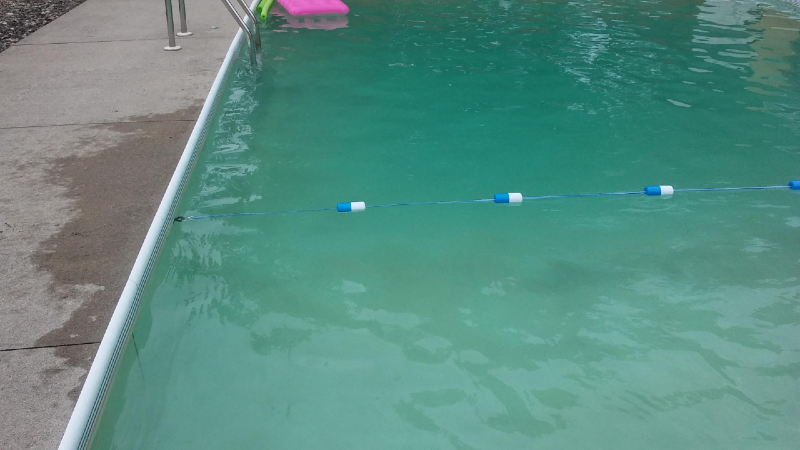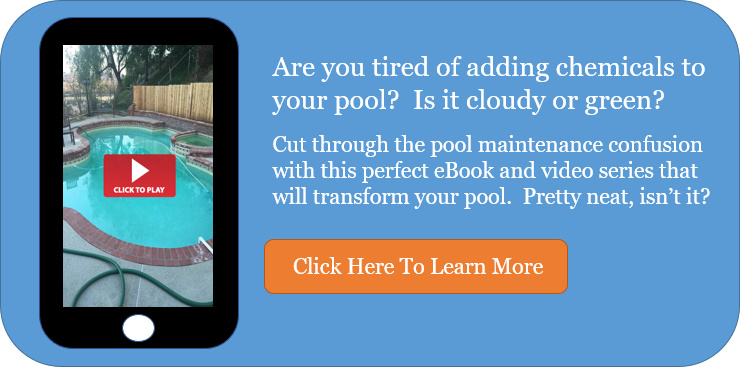How To Clear Up Green Salt Water Pool
How Clear Up A Green Salt Water Pool In 9 Steps
Salt water pools use the process of electrolysis to sanitize your pool water. Salt is added to the water and the electrolyzer (chlorine generator) is connected to the pool's filtration plumbing on the return side. The salt water passes through the chlorine generator which turns it into active hypochlorous acid, or pool chlorine. Also, a good salt water chlorinator can give you a choice when it comes to chlorinating your pool. A salt water pool system simply takes the salt and produces chlorine, but salt pools can still go as green as regular chlorine pools.

Why Did My Salt Water Pool Go Green?
Your pool is up and running and everything looks good, then it turns green on you when you least expect it. What happened? We'll look at what causes a salt water pool to turn green.
1. Lack Of Chlorine
The most common reason why a salt water pool goes green is a lack of chlorine. Without the proper amount of chlorine, your pool water can quickly start to grow algae.
2. Bad Pool Chemistry
Yes, it's true. Pool chemistry is the cornerstone of clean and clear water. Without properly balancing the pool water, your pool can go green within a day or two. The pool test kit for professionals is the Taylor K-2006.
3. Poor Filtration
We'll never keep our pools balanced without testing the chemicals. And we'll never clear dirty water with a dirty or non-working filter. Clogged or bad filters, and even poorly working pump motors, can cause many issues with cloudy and green pools.
4. Incorrect Amount Of Salt
A chlorine generator needs a specific amount of salt in order to perform its functions properly. The normal range for many salt chlorine generators is 2500 ppm - 450 ppm. Not having enough, or having too much salt, will make it difficult for your cell to do its job of producing chlorine.
Salt Water Chlorination
We should know that a salt water pool is not a chlorine free pool. Ideally, it should have the same amount of free chlorine as any regular chlorine pool. It's the chlorine generator that does the job of adding chlorine to your salt pool. After adding salt to your pool, the water flows through the salt chlorine generator and through the process of electrolysis, hypochlorous acid (HClO) and sodium hypochlorite (NaClO), the compound commonly known as chlorine, is added to your pool.
Super Chlorination
A quick note about super chlorination on your chlorine generator. Most salt water chlorinators have the ability to immediately raise the free chlorine concentration in your pool water. You'll use this mode whenever your pool experiences a heavy bather load, or things outside your control such as heavy rain. You can also use this function during weekly super chlorinating, just as you would add shock to a regular chlorine pool. The downside is the shock level on your chlorine generator is not designed to attack an already existing algae problem.

How To Fix A Green Salt Water Pool
If you have an already existing algae problem, then you're going to need to attack it the old fashioned way.
1. Clean The Filter
Cleaning dirty water with a dirty or non-working filter or filtration system will never work. Our first step is to make sure our filter is very clean and perfectly working. Backwash your sand or DE filter. If you have a cartridge filter, make sure you take it out and spray it off with a garden hose and sprayer. If your cartridge has over 3000 filter hours on it, you'll need to replace it and get a new one.
2. Test and Balance Your Pool Water
Bring the pH, alkalinity, and hardness into line. Adjust your pH to 7.0-7.2. Chlorine is more active at a slightly lower pH level. Adjust your alkalinity to 80-120 ppm and hardness to 150-250 ppm. Remember to maintain your CYA level at 30 - 50 ppm. I use and recommend the Taylor K-2006 pool test kit.
3. Brush The Pool With A Nylon Brush
Algae will try to stick to your pool surface, so give it a good brushing at least twice per day. If you have a plaster or concrete pool, go ahead and use a wire brush. Never use a wire brush on a vinyl or fiberglass pool.
4. Shock Your Pool
Watch the video below to see the proper way of shocking your pool. Increase and maintain a free chlorine level of at least 20 ppm using liquid pool chlorine or bleach. Your chlorine level will always decrease, so it's important to keep an eye on the chlorine level and keep it high. Make sure your chlorine generator is turned OFF during this process.
5. Keep Your Pump Motor On and Keep Filtering
Keep that pump motor on 24/7 until the entire process is finished. All of those dead and dying algae particles are going to be floating in your pool water and they need a place to go. That place it in your filter where they'll be trapped and waiting to be cleaned or backwashed out.
6. Shock Your Pool Again
Let's remember that shocking a pool is a process, not an event. Your chlorine level will always be decreasing so maintaining a high chlorine level is a must in order to kill the green algae.
7. Clean The Filter
The first time you backwashed or cleaned the filter, it was in preparation for clearing up your pool. Now your filter has captured much of the dead and dying green algae and that yucky stuff needs to go somewhere. That somewhere is out of your filter. So backwash your sand or DE filter, or clean your cartridge filter again.
8. Test and Balance Your Pool Water
After all that work your green algae problem should be in the past. Now it's time to balance your pool water once more. Your chlorine might be a little on the high side, but it'll decrease in time. Next, your pH might be above the normal range of 7.2 - 7.8. A little muriatic or dry acid will bring it back down again.
9. Keep an Eye Out
Over the next few days and weeks, keep your eyes open for any sings of reoccurring algae. Maintain the right chlorine level of 2 - 4 ppm. At the very tail end of the clearing process, you can add a maintenance dose of clarifier. This helps clumps the smaller particles together for easier filtering.
Easy Ways To Prevent Algae In Your Salt Water Pool
Adding a PolyQuat 60 algaecide is a good preventative measure against algae, but there are a few easy things we can do to help prevent the growth of algae in our pool.
- Take a hot soapy shower before entering the pool and ask your swimming guests to do the same.
- Maintain the right level of chlorine. Optimally, your chlorine level should be 2 - 4 ppm.
- Wash swim suits often in hot water and dry in the clothes dryer.
- Clean pool toys with a 50/50 mixture of bleach and water. Remove pool toys from the water when not in use.
- Keep your pool water balanced.
- Keep your filter clean and in good working condition.
One Last Thought About A Green Salt Water Pool
You're not alone. Even the most seasoned pool owner will sometimes fight a green pool. Fortunately, you're armed with the best methods for killing that algae. Let's get on it quickly, clear it up, and get back to swimming!!
How To Clear Up Green Salt Water Pool
Source: https://www.clean-pool-and-spa.com/salt-water-pool-green.html
Posted by: mccarterhable1977.blogspot.com

0 Response to "How To Clear Up Green Salt Water Pool"
Post a Comment